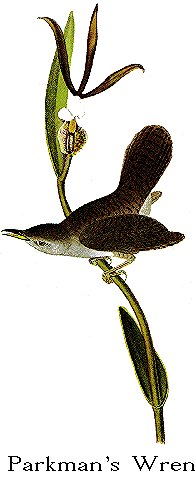
| Family IX. CERTHIANIE. CREEPERS. GENUS II. TROGLODYTES, Cuv. WREN. |
Next >> |

Family |
PARKMAN'S WREN. [House Wren (see also House Wren and Wood Wren).] |
| Genus | TROGLODYTES PARKMANII, Aud. [Troglodytes aedon.] |
A single specimen of this Wren which differs considerably from Troglodytes
hyemalis and T. europaeus, has been sent to me by Mr. TOWNSEND, who procured it
on the Columbia river, along with several others, all exactly similar. The
principal difference is in the bill, which is much longer, stouter, and
decidedly arched. The wings also are considerably longer, as is the tail in a
still greater degree. The plumage is similar, and presents nearly the same
markings, but the colours are much paler, and the lower parts nearly
greyish-white. This, however, may be merely the effect of the weather. This
species may be briefly characterized as follows:
T. Parkmanii. The bill much longer, stouter, and more curved than that of
T. Hyemalis; the upper parts reddish-brown, faintly barred with dusky, the lower
parts dull brownish-white; the sides barred with brownish-black and
greyish-white, the foreneck and breast with scarcely any markings, the lower
wing-coverts and axillars greyish-white, obscurely barred with dusky; the tail
half an inch longer than that of the common species, and more rounded.
Bill rather long, slender, tapering; as broad as high at the base, slightly
arched, compressed toward the end. Upper mandible with the dorsal outline
slightly arched, the ridge narrow, the sides sloping at the base, toward the end
slightly convex and erect, the edges sharp, direct, without notch; lower
mandible with the angle narrow and rather acute, the dorsal outline decurved in
an almost imperceptible degree, the back narrow, the edges sharp and inflected,
the tip very narrow; the gape-line slightly arched. Nostrils oblong, basal,
operculate.
Head ovate, of moderate size; neck short. Feet of ordinary length; tarsus
compressed, with seven anterior scutella, all of which are very distinct; toes
rather large, compressed; first large, and much longer than the two lateral, of
which the inner is a little shorter; the third and fourth coherent as far as the
second joint of the latter. Claws long, arched, extremely compressed, laterally
grooved, acute.
Plumage soft and blended; no bristle-feathers at the base of the bill.
Wing of moderate length, broad, much rounded; the first quill very small, being
only half the length of the second, which is three and a half twelfths shorter
than the third; the fourth longest, and exceeding the third by half a twelfth,
and the fourth by scarcely a quarter of a twelfth; secondaries long and rounded.
Tail rather long, much rounded, the lateral feathers being nearly half an inch
shorter than the middle.
Bill dusky brown, with the basal edges of the upper and two-thirds of the
lower mandible pale. Tarsi greyish-yellow; toes and claws light brownish. The
general colour of the upper parts is reddish-brown, tinged with grey. There is
a white spot near the tips of the posterior dorsal feathers. The secondary
coverts, and the first small coverts, have each a white spot at the tip. The
wing-coverts and quills are banded with blackish-brown and dull brownish-red,
the bands of the latter colour paler on the outer quills; the inner webs and
tips of all the quills plain brown, as in the other species. All the upper
parts are more faintly barred in the same manner. On the tail are twelve dusky
bars, as in T. hyemalis. A dull whitish band from the upper mandible over the
eye; the cheeks whitish, with the basil margins of the feathers brown; the lower
parts are dull brownish-white, tinged with grey, the sides brownish, barred with
dusky; the fore neck and breast with faint indications of bars; the lower
wing-coverts and axillaries greyish-white, some of the former with dusky
markings; the lower tail-coverts brownish-white, barred with dusky.
Length to end of tail 4 2/12 inches, to end of wings 3 7/12; bill along the
ridge 7 1/2; wing from flexure 2 1/4; tail 1 11/12; tarsus 8/12; hind toe
(4 1/4)/12, its claw 4/12; middle toe 6/12, its claw (2 1/2)/12.
Feeling perfectly confident that this species is distinct from any other,
and not finding it anywhere described, I have named it after my most kind,
generous, and highly talented friend GEORGE PARKMAN, Esq., M. D., of Boston, as
an indication of the esteem in which I hold him, and of the gratitude which I
ever cherish towards him.
PARKMAN'S WREN, Troglodytes Parkmanii, Aud. Orn. Biog., vol. v. p. 310.
Nuttall, Man., vol. i. p. 483. (Second Edition.)
| Next >> |